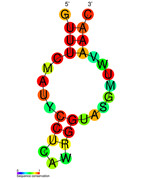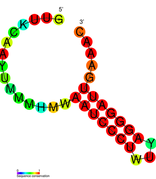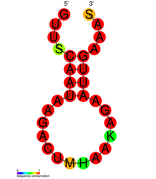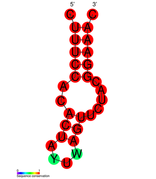CRISPR

CRISPRs (Clustered Regularly Interspaced Short Palindromic Repeats) are loci containing multiple short direct repeats that are found in the genomes of approximately 40% of sequenced bacteria and 90% of sequenced archaea.[2][3] CRISPR functions as a prokaryotic immune system, in that it confers resistance to exogenous genetic elements such as plasmids and phages.[4][5] The CRISPR system provides a form of acquired immunity. Short segments of foreign DNA, called spacers, are incorporated into the genome between CRISPR repeats, and serve as a 'memory' of past exposures.[6] CRISPR spacers are then used to recognize and silence exogenous genetic elements in a manner analogous to RNAi in eukaryotic organisms.[6]
Discovery of CRISPR
The clustered genomic repeats that are today known as CRISPR were first described in 1987 for the bacterium Escherichia coli.[7] In 2000, similar clustered repeats were identified in the genomes of additional bacteria and archaea, and were termed Short Regularly Spaced Repeats (SRSR).[8] SRSR were renamed CRISPR in 2002.[9] A set of genes, some encoding putative nuclease or helicase proteins, were found to be associated with CRISPR repeats (the cas, or CRISPR-associated, genes).[9] Further in 2005, three independent researchers showed that CRISPR spacers showed homology to the several phage DNA and extrachromosomal DNA such as plasmids. This was an indication that CRSIPR/cas system could have a role in adaptive immunity in Bacteria.[10]CRISPR was first shown to work in human cells by George Church at Harvard University. [11]

CRISPR locus structure
CRISPR repeats and spacers
CRISPR repeats range in size from 24 to 48 base pairs.[12] They usually show some dyad symmetry, implying the formation of a secondary structure such as a hairpin, but are not truly palindromic.[13] CRISPR repeats are separated by spacers of similar length.[12] Some CRISPR spacer sequences have identity to sequences from plasmids and phage,[14][15][16] although some spacers have identity to the prokaryote's own genome (self-targeting spacers).[17] New spacers can be added rapidly in response to phage infection.[18]
cas genes and CRISPR subtypes
The CRISPR-associated (cas) genes are often associated with CRISPR repeat-spacer arrays. More than forty different Cas protein families have been described.[12] Of these protein families, Cas1 appears to be ubiquitous among different CRISPR/Cas systems. Particular combinations of cas genes and repeat structures have been used to define 8 CRISPR subtypes (Ecoli, Ypest, Nmeni, Dvulg, Tneap, Hmari, Apern, and Mtube), some of which are associated with an additional gene module encoding repeat-associated mysterious proteins (RAMPs).[12] More than one CRISPR subtype may occur in a single genome. The sporadic distribution of the CRISPR/Cas subtypes suggests that the system is subject to horizontal gene transfer during microbial evolution.
| CRISPR associated protein | |||||||||
|---|---|---|---|---|---|---|---|---|---|
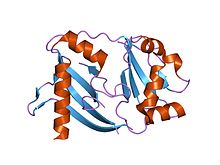 crystal structure of a crispr-associated protein from thermus thermophilus | |||||||||
| Identifiers | |||||||||
| Symbol | CRISPR_assoc | ||||||||
| Pfam | PF08798 | ||||||||
| Pfam clan | CL0362 | ||||||||
| InterPro | IPR010179 | ||||||||
| CDD | cd09727 | ||||||||
| |||||||||
| CRISPR associated protein Cas2 | |||||||||
|---|---|---|---|---|---|---|---|---|---|
 crystal structure of a hypothetical protein tt1823 from thermus thermophilus | |||||||||
| Identifiers | |||||||||
| Symbol | CRISPR_Cas2 | ||||||||
| Pfam | PF09827 | ||||||||
| InterPro | IPR019199 | ||||||||
| CDD | cd09638 | ||||||||
| |||||||||
| CRISPR-associated protein Cse1 | |||||||||
|---|---|---|---|---|---|---|---|---|---|
| Identifiers | |||||||||
| Symbol | CRISPR_Cse1 | ||||||||
| Pfam | PF09481 | ||||||||
| InterPro | IPR013381 | ||||||||
| CDD | cd09729 | ||||||||
| |||||||||
| CRISPR-associated protein Cse2 | |||||||||
|---|---|---|---|---|---|---|---|---|---|
| Identifiers | |||||||||
| Symbol | CRISPR_Cse2 | ||||||||
| Pfam | PF09485 | ||||||||
| InterPro | IPR013382 | ||||||||
| CDD | cd09670 | ||||||||
| |||||||||
CRISPR mechanism
Exogenous DNA is apparently processed by proteins encoded by some of the CRISPR-associated (cas) genes into small elements (of ~30bp in length), which are then somehow inserted into the CRISPR locus near the leader sequence. RNAs from the CRISPR loci are constitutively expressed and are processed by Cas proteins to small RNAs composed of individual exogenously derived sequence elements with some flanking repeat sequence. The RNAs guide other Cas proteins to silence exogenous genetic elements at the RNA or DNA level.[1][19] There is evidence for functional diversity among the different CRISPR subtypes. The Cse (Cas subtype Ecoli) proteins (called CasA-E in E. coli) form a functional complex, Cascade, that processes CRISPR RNA transcripts into spacer-repeat units that are retained by Cascade.[20] In other prokaryotes, Cas6 processes the CRISPR transcripts. Interestingly, CRISPR-based phage inactivation in E. coli requires Cascade and Cas3, but not Cas1 and Cas2. The Cmr (Cas RAMP module) proteins found in Pyrococcus furiosus and other prokaryotes form a functional complex with small CRISPR RNAs that recognizes and cleaves complementary target RNAs. RNA-guided CRISPR enzymes are classified as type V restriction enzymes.
Evolutionary significance and possible applications
A bioinformatic study has shown that the CRISPRs are evolutionarily conserved and cluster into related types. Many show signs of a conserved secondary structure.[13]
Through the CRISPR-Cas mechanism bacteria can acquire immunity against certain phages and thus halt further transmission of targeted phages. For this reason, some researchers have proposed that the CRISPR-Cas system is a Lamarckian inheritance mechanism.[21] Others investigated the coevolution of host and viral genomes by analysis of CRISPR sequences.[22]
The proof-of-principle demonstration of selective engineered redirection of the CRISPR-Cas system in 2012[23] provided a first step toward realization of some of the several proposals for CRISPR-derived biotechnology:[24]
- Artificial immunization against phage by introduction of engineered CRISPR loci in industrially important bacteria, including those used in food production and large-scale fermentations.
- Genome engineering at cellular or organismic level by reprogramming of a CRISPR-Cas system to achieve RNA-guided genome engineering, proof of concept studies has demonstrated examples on this front both in vitro and in vivo.[25][26][27][28][29]
- Knockdown of endogenous genes by transformation with a plasmid which contains a CRISPR area with a spacer, which inhibits a target gene.
- Discrimination of different bacterial strains by comparison of CRISPR spacer sequences (spoligotyping).
CRISPR/Cas system in phage
Another way that bacteria can defend against phage infection is by having chromosomal islands. A subtype of chromosomal islands called phage-inducible chromosomal island (PICI) is excised from bacterial chromosome upon phage infection and can inhibit phage replication.[30] The mechanisms that induce PICI excision and how PICI inhibits phage replication are still not well understood. Recently, however, a study has shown that lytic ICP1 phage that specifically targets Vibrio cholerae serogroup O1 has acquired a CRISPR/Cas system that targets V. cholera PICI-like element. Phage’s CRISPR/Cas system has 2 CRISPR loci and 9 cas genes and seems to be homologous to the 1-F system found in Yersinia pestis. Moreover, like the bacterial CRISPR/Cas system, ICP1 CRISPR/Cas system can also acquire new sequences, which allows the phage to co-evolve with its host.[31]
References
- ^ a b c Horvath P, Barrangou R (2010). "CRISPR/Cas, the immune system of bacteria and archaea". Science. 327 (5962): 167–70. doi:10.1126/science.1179555. PMID 20056882.
{{cite journal}}: Unknown parameter|month=ignored (help) - ^ 71/79 Archaea, 463/1008 Bacteria CRISPRdb, Date: 19.6.2010
- ^ Grissa I, Vergnaud G, Pourcel C (2007). "The CRISPRdb database and tools to display CRISPRs and to generate dictionaries of spacers and repeats". BMC Bioinformatics. 8: 172. doi:10.1186/1471-2105-8-172. PMC 1892036. PMID 17521438.
{{cite journal}}: CS1 maint: multiple names: authors list (link) CS1 maint: unflagged free DOI (link) - ^ Barrangou R, Fremaux C, Deveau H; et al. (2007). "CRISPR provides acquired resistance against viruses in prokaryotes". Science. 315 (5819): 1709–12. doi:10.1126/science.1138140. PMID 17379808.
{{cite journal}}: Explicit use of et al. in:|author=(help); Unknown parameter|month=ignored (help)CS1 maint: multiple names: authors list (link) - ^ Marraffini LA, Sontheimer EJ (2008). "CRISPR Interference Limits Horizontal Gene Transfer in Staphylococci by Targeting DNA". Science. 322 (5909): 1843–5. doi:10.1126/science.1165771. PMC 2695655. PMID 19095942.
{{cite journal}}: Unknown parameter|month=ignored (help) - ^ a b c Marraffini LA, Sontheimer EJ (2010). "CRISPR interference: RNA-directed adaptive immunity in bacteria and archaea". Nat Rev Genet. 11 (3): 181–190. doi:10.1038/nrg2749. PMC 2928866. PMID 20125085.
{{cite journal}}: Unknown parameter|month=ignored (help) - ^ Ishino Y, Shinagawa H, Makino K, Amemura M, Nakata A (1987). "Nucleotide sequence of the iap gene, responsible for alkaline phosphatase isozyme conversion in Escherichia coli, and identification of the gene product". J Bacteriol. 169 (12): 5429–33. PMC 213968. PMID 3316184.
{{cite journal}}: CS1 maint: multiple names: authors list (link) - ^ Mojica FJM, Díez-Villaseñor C, Soria E, Juez G (2000). "Biological significance of a family of regularly spaced repeats in the genomes of Archaea, Bacteria and mitochondria". Mol Microbiol. 36 (1): 244–6. doi:10.1046/j.1365-2958.2000.01838.x. PMID 10760181.
{{cite journal}}: CS1 maint: multiple names: authors list (link) - ^ a b Jansen R, Embden JD, Gaastra W, Schouls LM (2002). "Identification of genes that are associated with DNA repeats in prokaryotes". Mol Microbiol. 43 (6): 1565–75. doi:10.1046/j.1365-2958.2002.02839.x. PMID 11952905.
{{cite journal}}: CS1 maint: multiple names: authors list (link) - ^ Horvath, Philippe (8). "Dr". Science. 327 (167): 167. doi:10.1126/science.1179555.
{{cite journal}}: Check date values in:|year=,|date=, and|year=/|date=mismatch (help); More than one of|pages=and|page=specified (help); Unknown parameter|month=ignored (help) - ^ http://www.independent.co.uk/news/science/crispr-gene-therapy-scientists-call-for-more-public-debate-around-breakthrough-technique-8927606.html
- ^ a b c d Haft DH, Selengut J, Mongodin EF, Nelson KE (2005). "A Guild of 45 CRISPR-Associated (Cas) Protein Families and Multiple CRISPR/Cas Subtypes Exist in Prokaryotic Genomes". PLoS Comput Biol. 1 (6): e60. doi:10.1371/journal.pcbi.0010060. PMC 1282333. PMID 16292354.
{{cite journal}}: CS1 maint: multiple names: authors list (link) CS1 maint: unflagged free DOI (link) - ^ a b Kunin V, Sorek R, Hugenholtz P (2007). "Evolutionary conservation of sequence and secondary structures in CRISPR repeats". Genome Biol. 8 (4): R61. doi:10.1186/gb-2007-8-4-r61. PMC 1896005. PMID 17442114.
{{cite journal}}: CS1 maint: multiple names: authors list (link) CS1 maint: unflagged free DOI (link) - ^ Mojica FJ, Díez-Villaseñor C, García-Martínez J, Soria E (2005). "Intervening sequences of regularly spaced prokaryotic repeats derive from foreign genetic elements". J. Mol. Evol. 60 (2): 174–82. doi:10.1007/s00239-004-0046-3. PMID 15791728.
{{cite journal}}: Unknown parameter|month=ignored (help)CS1 maint: multiple names: authors list (link) - ^ Bolotin A, Quinquis B, Sorokin A, Ehrlich SD (2005). "Clustered regularly interspaced short palindrome repeats (CRISPRs) have spacers of extrachromosomal origin". Microbiology (Reading, Engl.). 151 (Pt 8): 2551–61. doi:10.1099/mic.0.28048-0. PMID 16079334.
{{cite journal}}: Unknown parameter|month=ignored (help)CS1 maint: multiple names: authors list (link) - ^ Pourcel C, Salvignol G, Vergnaud G (2005). "CRISPR elements in Yersinia pestis acquire new repeats by preferential uptake of bacteriophage DNA, and provide additional tools for evolutionary studies". Microbiology. 151 (Pt 3): 653–63. doi:10.1099/mic.0.27437-0. PMID 15758212.
{{cite journal}}: CS1 maint: multiple names: authors list (link) - ^ Stern A, Keren L, Wurtzel O, Amitai G, Sorek R (2010). "Self-targeting by CRISPR: gene regulation or autoimmunity?". Trends Genet. 26 (8): 335–40. doi:10.1016/j.tig.2010.05.008. PMC 2910793. PMID 20598393.
{{cite journal}}: Unknown parameter|month=ignored (help)CS1 maint: multiple names: authors list (link) - ^ Tyson GW, Banfield JF (2008). "Rapidly evolving CRISPRs implicated in acquired resistance of microorganisms to viruses". Environ. Microbiol. 10 (1): 200–7. doi:10.1111/j.1462-2920.2007.01444.x. PMID 17894817.
{{cite journal}}: Unknown parameter|month=ignored (help) - ^ Makarova KS, Grishin NV, Shabalina SA, Wolf YI, Koonin EV (2006). "A putative RNA-interference-based immune system in prokaryotes: computational analysis of the predicted enzymatic machinery, functional analogies with eukaryotic RNAi, and hypothetical mechanisms of action". Biol Direct. 1: 7. doi:10.1186/1745-6150-1-7. PMC 1462988. PMID 16545108.
{{cite journal}}: CS1 maint: multiple names: authors list (link) CS1 maint: unflagged free DOI (link) - ^ Brouns SJ, Jore MM, Lundgren M; et al. (2008). "Small CRISPR RNAs guide antiviral defense in prokaryotes". Science. 321 (5891): 960–4. doi:10.1126/science.1159689. PMID 18703739.
{{cite journal}}: Explicit use of et al. in:|author=(help); Unknown parameter|month=ignored (help)CS1 maint: multiple names: authors list (link) - ^ Koonin EV, Wolf YI (2009). "Is evolution Darwinian or/and Lamarckian?". Biol Direct. 4: 42. doi:10.1186/1745-6150-4-42. PMC 2781790. PMID 19906303.
{{cite journal}}: CS1 maint: unflagged free DOI (link) - ^ Heidelberg JF, Nelson WC, Schoenfeld T, Bhaya D (2009). Ahmed, Niyaz (ed.). "Germ Warfare in a Microbial Mat Community: CRISPRs Provide Insights into the Co-Evolution of Host and Viral Genomes". PLoS ONE. 4 (1): e4169. doi:10.1371/journal.pone.0004169. PMC 2612747. PMID 19132092.
{{cite journal}}: CS1 maint: multiple names: authors list (link) CS1 maint: unflagged free DOI (link) - ^ Hale, Caryn R.; Majumdar, Sonali; Elmore, Joshua; Pfister, Neil; Compton, Mark; Olson, Sara; Resch, Alissa M.; Glover, Claiborne V.C. (5 Jan 2012), "Essential Features and Rational Design of CRISPR RNAs that Function with the Cas RAMP Module Complex to Cleave RNAs", Molecular Cell, New Articles (preprints), doi:10.1016/j.molcel.2011.10.023, retrieved 6 Jan 2012
{{citation}}: Unknown parameter|coauthors=ignored (|author=suggested) (help) - ^ Sorek R, Kunin V, Hugenholtz P (2008). "CRISPR--a widespread system that provides acquired resistance against phages in bacteria and archaea". Nat Rev Microbiol. 6 (3): 181–6. doi:10.1038/nrmicro1793. PMID 18157154.
{{cite journal}}: CS1 maint: multiple names: authors list (link) - ^ Jinek, M (2012). "A programmable dual-RNA-guided DNA endonuclease in adaptive bacterial immunity". Science. 337 (6096): 816–21. doi:10.1126/science.1225829. PMID 22745249.
{{cite journal}}: Unknown parameter|coauthors=ignored (|author=suggested) (help) - ^ Cong, Le (2013). "Multiplex genome engineering using CRISPR/Cas systems". Science. 339 (6121): 819–23. doi:10.1126/science.1231143. PMID 23287718.
{{cite journal}}: Unknown parameter|coauthors=ignored (|author=suggested) (help) - ^ Mali, P (2013). "RNA-guided human genome engineering via Cas9". Science. 339 (6121): 823–6. doi:10.1126/science.1232033. PMID 23287722.
{{cite journal}}: Unknown parameter|coauthors=ignored (|author=suggested) (help) - ^ Wang, H (2013). "One-Step Generation of Mice Carrying Mutations in Multiple Genes by CRISPR/Cas-Mediated Genome Engineering". Cell. 153 (4): 910–8. doi:10.1016/j.cell.2013.04.025. PMID 23643243.
{{cite journal}}: Unknown parameter|coauthors=ignored (|author=suggested) (help) - ^ Houa, Z; Zhangb,Y; Propsona, N; Howdena, S; Chua, L; Sontheimerb, E; and Thomson, J. (2013) Efficient genome engineering in human pluripotent stem cells using Cas9 from Neisseria meningitidis. PNAS. doi:10.1073/pnas.1313587110
- ^ Novick RP, Christie GE, Penadés JR (2010). "The phage-related chromosomal islands of Gram-positive bacteria". Nat. Rev. Microbiol. 8 (8): 541–51. doi:10.1038/nrmicro2393. PMC 3522866. PMID 20634809.
{{cite journal}}: Unknown parameter|month=ignored (help)CS1 maint: multiple names: authors list (link) - ^ Seed KD, Lazinski DW, Calderwood SB, Camilli A (2013). "A bacteriophage encodes its own CRISPR/Cas adaptive response to evade host innate immunity". Nature. 494 (7438): 489–91. doi:10.1038/nature11927. PMID 23446421.
{{cite journal}}: Unknown parameter|month=ignored (help)CS1 maint: multiple names: authors list (link)
Further reading
- Horvath P, Romero DA, Coûté-Monvoisin AC; et al. (2008). "Diversity, Activity, and Evolution of CRISPR Loci in Streptococcus thermophilus". J. Bacteriol. 190 (4): 1401–12. doi:10.1128/JB.01415-07. PMC 2238196. PMID 18065539.
{{cite journal}}: Explicit use of et al. in:|author=(help); Unknown parameter|month=ignored (help)CS1 maint: multiple names: authors list (link) - Deveau H, Barrangou R, Garneau JE; et al. (2008). "Phage Response to CRISPR-Encoded Resistance in Streptococcus thermophilus". J. Bacteriol. 190 (4): 1390–400. doi:10.1128/JB.01412-07. PMC 2238228. PMID 18065545.
{{cite journal}}: Explicit use of et al. in:|author=(help); Unknown parameter|month=ignored (help)CS1 maint: multiple names: authors list (link) - Andersson AF, Banfield JF (2008). "Virus population dynamics and acquired virus resistance in natural microbial communities". Science. 320 (5879): 1047–50. doi:10.1126/science.1157358. PMID 18497291.
- Hale C, Kleppe K, Terns RM, Terns MP (2008). "Prokaryotic silencing (psi)RNAs in Pyrococcus furiosus". RNA. 14 (12): 2572–9. doi:10.1261/rna.1246808. PMC 2590957. PMID 18971321.
{{cite journal}}: Unknown parameter|month=ignored (help)CS1 maint: multiple names: authors list (link) - Carte J, Wang R, Li H, Terns RM, Terns MP (2008). "Cas6 is an endoribonuclease that generates guide RNAs for invader defense in prokaryotes". Genes Dev. 22 (24): 3489–96. doi:10.1101/gad.1742908. PMC 2607076. PMID 19141480.
{{cite journal}}: Unknown parameter|month=ignored (help)CS1 maint: multiple names: authors list (link) - Shah SA, Hansen NR, Garrett RA (2009). "Distribution of CRISPR spacer matches in viruses and plasmids of crenarchaeal acidothermophiles and implications for their inhibitory mechanism". Biochem. Soc. Trans. 37 (Pt 1): 23–8. doi:10.1042/BST0370023. PMID 19143596.
{{cite journal}}: Unknown parameter|month=ignored (help)CS1 maint: multiple names: authors list (link) - Lillestøl RK, Shah SA, Brügger K; et al. (2009). "CRISPR families of the crenarchaeal genus Sulfolobus: bidirectional transcription and dynamic properties". Molecular Microbiology. 72 (1): 259–72. doi:10.1111/j.1365-2958.2009.06641.x. PMID 19239620.
{{cite journal}}: Explicit use of et al. in:|author=(help); Unknown parameter|month=ignored (help)CS1 maint: multiple names: authors list (link) - Mojica FJ, Díez-Villaseñor C, García-Martínez J, Almendros C (2009). "Short motif sequences determine the targets of the prokaryotic CRISPR defence system". Microbiology (Reading, Engl.). 155 (Pt 3): 733–40. doi:10.1099/mic.0.023960-0. PMID 19246744.
{{cite journal}}: Unknown parameter|month=ignored (help)CS1 maint: multiple names: authors list (link) - van der Ploeg JR (2009). "Analysis of CRISPR in Streptococcus mutans suggests frequent occurrence of acquired immunity against infection by M102-like bacteriophages". Microbiology (Reading, Engl.). 155 (Pt 6): 1966–76. doi:10.1099/mic.0.027508-0. PMID 19383692.
{{cite journal}}: Unknown parameter|month=ignored (help) - Hale CR, Zhao P, Olson S; et al. (2009). "RNA-Guided RNA Cleavage by a CRISPR RNA-Cas Protein Complex". Cell. 139 (5): 945–56. doi:10.1016/j.cell.2009.07.040. PMC 2951265. PMID 19945378.
{{cite journal}}: Explicit use of et al. in:|author=(help); Unknown parameter|month=ignored (help)CS1 maint: multiple names: authors list (link) - van der Oost J, Brouns SJ (2009). "RNAi: prokaryotes get in on the act". Cell. 139 (5): 863–5. doi:10.1016/j.cell.2009.11.018. PMID 19945373.
{{cite journal}}: Unknown parameter|month=ignored (help) - Marraffini LA, Sontheimer EJ (2010). "Self vs. non-self discrimination during CRISPR RNA-directed immunity". Nature. 463 (7280): 568–71. doi:10.1038/nature08703. PMC 2813891. PMID 20072129.
{{cite journal}}: Unknown parameter|month=ignored (help) - Karginov FV, Hannon GJ (2010). "The CRISPR system: small RNA-guided defense in bacteria and archaea". Mol. Cell. 37 (1): 7–19. doi:10.1016/j.molcel.2009.12.033. PMC 2819186. PMID 20129051.
{{cite journal}}: Unknown parameter|month=ignored (help) - Pul U, Wurm R, Arslan Z, Geissen R, Hofmann N, Wagner R (2010). "Identification and characterization of E. coli CRISPR-cas promoters and their silencing by H-NS". Molecular Microbiology. 75 (6): 1495–512. doi:10.1111/j.1365-2958.2010.07073.x. PMID 20132443.
{{cite journal}}: Unknown parameter|month=ignored (help)CS1 maint: multiple names: authors list (link) - Díez-Villaseñor C, Almendros C, García-Martínez J, Mojica FJ (2010). "Diversity of CRISPR loci in Escherichia coli". Microbiology (Reading, Engl.). 156 (Pt 5): 1351–61. doi:10.1099/mic.0.036046-0. PMID 20133361.
{{cite journal}}: Unknown parameter|month=ignored (help)CS1 maint: multiple names: authors list (link) - Deveau H, Garneau JE, Moineau S (2010). "CRISPR/Cas System and Its Role in Phage-Bacteria Interactions". Annu Rev Microbiol. 64: 475–93. doi:10.1146/annurev.micro.112408.134123. PMID 20528693.
{{cite journal}}: Unknown parameter|month=ignored (help)CS1 maint: multiple names: authors list (link) - Koonin EV, Makarova KS (2009). "CRISPR-Cas: an adaptive immunity system in prokaryotes". F1000 Biol Rep. 1: 95. doi:10.3410/B1-95. PMC 2884157. PMID 20556198.
{{cite journal}}: Unknown parameter|month=ignored (help) - Touchon M, Rocha EP (2010). Randau, Lennart (ed.). "The Small, Slow and Specialized CRISPR and Anti-CRISPR of Escherichia and Salmonella". PLoS ONE. 5 (6): e11126. doi:10.1371/journal.pone.0011126. PMC 2886076. PMID 20559554.
{{cite journal}}: CS1 maint: unflagged free DOI (link)
External links
- E-CRISP.org A comprehensive software for CRISPR gRNA design
- [1] CRISPR Design Tool
- [2] Tool for finding CRISPRs
- [3] Tool for finding CRISPR targets in other nucleic acids
- Rfam page for the CRISPR entries

